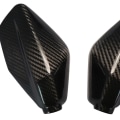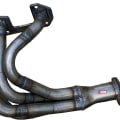Aerodynamic enhancements are essential for improving the performance of a car. By making cars more aerodynamic, they become more efficient and achieve higher speeds. In this article, we'll explain the different types of aerodynamic enhancements available and how they can help improve your vehicle's performance. Aerodynamics is the science of how air flows over a car's body. When air flows smoothly over a car, it creates less drag, allowing the car to move faster and use less fuel.
To achieve this, carmakers use various aerodynamic techniques to reduce drag and increase efficiency. These techniques range from simple changes like adding spoilers to more complex modifications such as redesigning the car's shape. The most common aerodynamic enhancement is the addition of spoilers and other body modifications that reduce drag. Spoilers disrupt the air flow around the car, creating turbulence that reduces the amount of drag. Other body modifications may include changing the angle of the car's nose or adding air intakes to improve airflow.
Additionally, some cars may be fitted with air dams, which are flat plates that sit at the front of the car and help channel airflow. Another type of aerodynamic enhancement is using aerodynamic materials. These materials have a lower coefficient of drag than traditional materials, allowing for better airflow around the car. Some examples of these materials include carbon fiber, Kevlar, and fiberglass. Finally, aerodynamic tuning is a process used to optimize a car's aerodynamics. This process involves adjusting the angles and shapes of various components on the car to reduce drag and increase efficiency.
Through this process, cars can be tuned to achieve maximum performance. Aerodynamic enhancements are modifications made to a vehicle to increase its aerodynamic efficiency. They can range from simple modifications such as changing the shape of the car, to more complex modifications such as installing air deflectors and spoilers. The goal of these modifications is to reduce drag on the vehicle, which in turn increases fuel economy, speed, and stability. The most common type of aerodynamic enhancement is a spoiler, which is a piece of material mounted on the rear of the car.
Spoilers direct air over the car, reducing drag and improving its aerodynamic efficiency. Other types of aerodynamic enhancement include air deflectors, which redirect air around the sides of the car; underbody panels, which cover the underside of the car; and side skirts, which reduce airflow around the sides of the car. One of the main benefits of aerodynamic enhancements is improved fuel economy. By reducing drag on the vehicle, aerodynamic modifications help it to move more efficiently, resulting in better fuel economy.
Additionally, aerodynamic enhancements can also increase speed and stability. The decreased drag reduces turbulence and makes it easier for the vehicle to stay on course at higher speeds. Installing aerodynamic enhancements on a Triumph TR vehicle is relatively straightforward and can be done with a few basic tools and materials. Underbody panels and side skirts can usually be installed with a few screws and bolts.
Air deflectors and spoilers may require some additional modifications, such as drilling holes for mounting bolts or cutting out pieces of the existing bodywork. In order to maintain aerodynamic efficiency, it is important to keep aerodynamic enhancements clean and free of debris. Dirt and debris can disrupt airflow over the car, resulting in reduced efficiency. Additionally, it is important to inspect aerodynamic enhancements regularly for signs of damage or wear-and-tear.
Any damaged parts should be replaced immediately in order to maintain optimal performance. Aerodynamic enhancements can make a huge difference to your Triumph TR vehicle's interior performance. With proper installation and maintenance, they can improve fuel economy, increase speed, and provide greater stability. By understanding the basics of aerodynamic enhancement and how they can be applied to a Triumph TR vehicle, you can upgrade your car's interior performance without spending a fortune.
Advantages and Disadvantages
Aerodynamic enhancements have both advantages and disadvantages.On the plus side, they can help improve fuel economy, increase speed, and improve stability. These enhancements can also reduce drag, allowing for smoother and more efficient travel. However, there are some drawbacks to aerodynamic enhancements as well. The modifications can cause additional noise and vibrations.
They can also reduce visibility from the driver's seat, as some of the components may block views. Overall, aerodynamic enhancements can be beneficial to a Triumph TR vehicle's interior performance. They can help improve fuel economy and increase speed, while also reducing drag. However, drivers should be aware of the potential noise, vibrations, and reduced visibility that may come with these modifications.
Types of Aerodynamic Enhancements
Aerodynamic enhancements are modifications designed to improve the aerodynamic properties of a vehicle.These modifications can include spoilers, splitters, splitters with wings, air dams, air inlets, diffusers, side skirts, canards, and vortex generators. Each of these components serves a specific purpose that affects the overall aerodynamics of the vehicle.
Spoilers
Spoilers are designed to reduce lift and increase downforce. They are usually located on the rear of the vehicle and can be either fixed or adjustable. Spoilers can be effective in increasing the grip on the rear wheels while also decreasing drag.Splitters
Splitters are typically located on the front of a vehicle and serve as a way to reduce lift and increase downforce.Splitters are usually made from metal and come in different shapes and sizes. They are designed to allow air to flow around the vehicle more efficiently.
Splitters With Wings
Splitters with wings are similar to regular splitters, but they also include wings which are designed to direct airflow away from the vehicle. This helps to reduce drag and provide additional downforce. Splitters with wings can be effective in improving aerodynamic performance.Air Dams
Air dams are located near the front of a vehicle and are designed to reduce lift and increase downforce.Air dams can be effective in reducing drag and increasing fuel efficiency. They can also be used to improve handling characteristics.
Air Inlets
Air inlets are located near the front of a vehicle and are designed to allow air into the engine bay. Air inlets help to keep the engine cool by allowing air to flow more efficiently. Air inlets can also be used to increase downforce.Diffusers
Diffusers are typically located near the rear of a vehicle and serve as a way to reduce drag and increase downforce.Diffusers are usually made from metal and come in different shapes and sizes. Diffusers help to direct airflow away from the vehicle which helps reduce drag.
Side Skirts
Side skirts are typically located near the sides of a vehicle and serve as a way to reduce drag and increase downforce. Side skirts can be made from metal or plastic and come in different shapes and sizes. Side skirts help to create an aerodynamic seal between the vehicle and the road surface.Canards
Canards are located near the front of a vehicle and are designed to reduce drag and increase downforce.Canards can be made from metal or plastic and come in different shapes and sizes. Canards help to create an aerodynamic seal between the vehicle and the road surface.
Vortex Generators
Vortex generators are small devices located on various parts of a vehicle. They help to reduce drag by creating a low-pressure area around the vehicle which helps to reduce turbulence. Vortex generators can also be used to increase downforce. In conclusion, aerodynamic enhancements can be a great way to improve the interior performance of your Triumph TR vehicle. Vortex generators are small devices located on various parts of a vehicle. They help to reduce drag by creating a low-pressure area around the vehicle which helps to reduce turbulence. Vortex generators can also be used to increase downforce. In conclusion, aerodynamic enhancements can be a great way to improve the interior performance of your Triumph TR vehicle.With the right modifications, you can enjoy improved fuel economy, higher top speeds, enhanced stability, reduced drag and more. However, there are some potential drawbacks to consider before making any modifications, such as increased noise levels and the need for regular maintenance. It is therefore important to research all available options carefully and consult with an expert if you have any questions. By understanding the basics of aerodynamic enhancement and the different types available, you can make the right decision for your vehicle and ensure that you maximize its interior performance.


